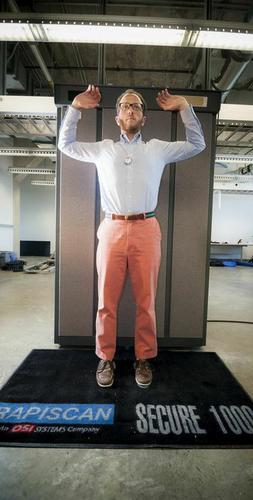
Hovav Shacham of the University of California at San Diego was part of a team of researchers who have showed how weapons can be concealed from the Rapiscan Secure 1000 body scanner, which was in wide use in U.S. airports through last year.
A type of body scanner in wide use across U.S. airports through last year fails to spot well-concealed weapons including guns and knives, computer security researchers contend.
The Rapiscan Secure 1000 full body scanner provides only "weak protection against adaptive adversaries," according to their paper, which will be presented on Thursday at the Usenix Security Symposium in San Diego. The researchers also set up a website with their findings.
"It is possible to conceal knives, guns and explosives from detection by exploiting properties of the device's backscatter X-ray technology," the paper said.
Although the Rapiscan Secure 1000 was retired from U.S. airport use last year, it is still used at court houses and prisons. Airports currently use millimeter-wave scanning technology, which the researchers have not tested.
The Transportation Security Administration, which is responsible for airport security, introduced advanced imaging technology such as the Rapiscan in 2009, spending more than US$1 billion in an effort to prevent terrorism.
The researchers bought a Rapiscan Secure 1000 body scanner from eBay. The seller had obtained the scanner in 2012 at a surplus auction of equipment from a U.S. government facility in Europe.
The technology in the Rapiscan Secure 1000 dates from the early 1990s. It uses ionizing radiation to find objects underneath clothing. The device has certain quirks, such as the inability to differentiate between an absence of matter and items with a high iron and lead content, resulting in black pixels on the screen.
TSA procedures for the Rapiscan called for passengers to be screened from the front and the back, which in some instances didn't catch carefully placed weapons, they wrote.
Two methods hid a .380 pistol from front and back scans: carefully affixing the gun to the outside of someone's leg with tape or sewing it inside the leg of the pants.
"In each case, the pistol is invisible against the dark background, and the attachment method leaves no other indication of the weapon's presence," according to the paper.
Another idiosyncrasy of the scanner is that items which scatter incoming X-rays with the same intensity of human flesh also appear invisible.
Covering an 18-inch knife with 1.5 cm of teflon tape -- which scatters X-rays nearly the same as flesh -- also obscured the weapon enough so that it appears to be part of a person's spine, they found.
Simulated plastic explosives such as C-4, when shaped in a thin pancake, also almost perfectly replicated the X-ray backscatter from a subject's stomach area. A metal detonator was placed in the person's navel, which absorbed enough X-rays to appear normal in a scan.
In some instances, performing side scans would have revealed the contraband, they wrote.
The researchers also experimented with how malicious software could be used in an attack, as the Rapiscan Secure 1000's console is an MS-DOS based PC.
The software lacked any passwords, making it possible for a determined attacker who can gain physical access to the machine to upload malware. The program they developed recorded and hid every scanned image for later retrieval.
The malware could also recognize a QR code worn on the shirt of a person who was being scanned and then substitute in a "clean" image.
While the Rapiscan Secure 1000 is fine for detecting unsophisticated attackers, it "performs less well against clever and adaptive adversaries," they wrote.
Part of the problem is that the manufacturers and the government have not allowed independent tests on such scanners for fear the disclosure of weakness could tip-off attackers to effective countermeasures, they wrote.
That strategy might be effective for some time, but it depends on maintaining tight purchase controls, they wrote.
"The root cause of many of the issues we describe seems to be failure of the system engineers to think adversarially," the paper said.
The study was co-authored by Keaton Mowery, Tom Wypych, Corey Singleton, Chris Comfort, Eric Rescorla and Hovav Shacham of the University of California at San Diego; Eric Wustrow and J. Alex Halderman of the University of Michigan; and Stephen Checkoway of Johns Hopkins University.
Send news tips and comments to jeremy_kirk@idg.com. Follow me on Twitter: @jeremy_kirk



